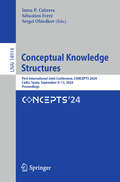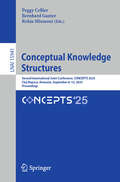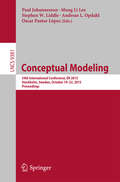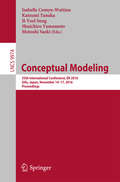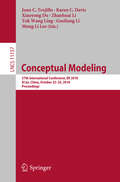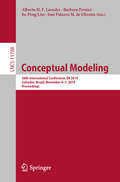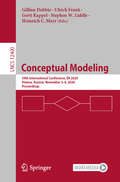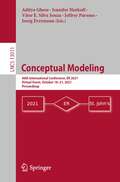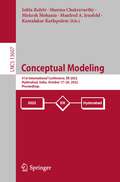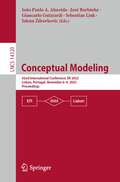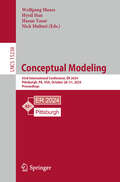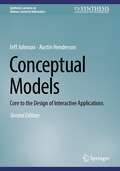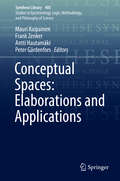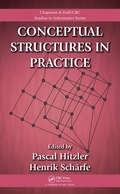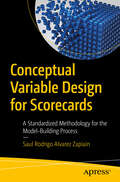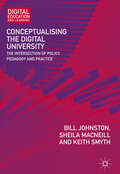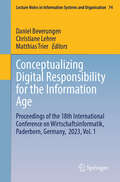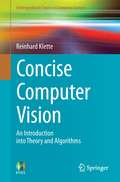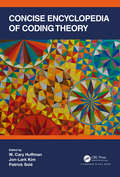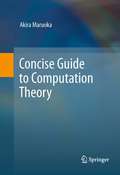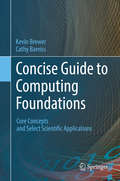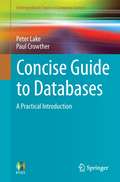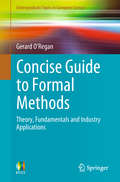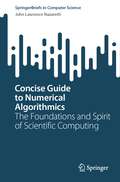- Table View
- List View
Conceptual Knowledge Structures: First International Joint Conference, CONCEPTS 2024, Cádiz, Spain, September 9–13, 2024, Proceedings (Lecture Notes in Computer Science #14914)
by Sébastien Ferré Sergei Obiedkov Inma P. CabreraThis book constitutes the proceedings of the First International Joint Conference on Conceptual Knowledge Structures, CONCEPTS 2024, which took place in Cádiz, Spain, during September 9-13, 2024. The conference is an amalgamation of the 18th International Conference on Formal Concept Analysis (ICFCA); the 17th International Conference on Concept Lattices and Their Applications (CLA); and the 28th International Conference on Conceptual Structures (ICCS). The 18 full and 4 short papers included in this book were carefully reviewed and selected from 38 submissions. They were organized in topical sections as follows: Theory; algorithms, methods, and resources; applications.
Conceptual Knowledge Structures: Second International Joint Conference, CONCEPTS 2025, Cluj-Napoca, Romania, September 8–12, 2025, Proceedings (Lecture Notes in Computer Science #15941)
by Bernhard Ganter Rokia Missaoui Peggy CellierThis book constitutes the refereed proceedings of the Second International Joint Conference on Conceptual Knowledge Structures, CONCEPTS 2025, held in Cluj-Napoca, Romania, during September 8–12, 2025. The 25 full papers and 2 short papers included in this book were carefully reviewed and selected from 33 submissions. They were organized in topical sections as follows: Methodology; Patterns, Clusters, Visualization and Software; Data Analysis; and Theory.
Conceptual Modeling: 34th International Conference, ER 2015, Stockholm, Sweden, October 19-22, 2015, Proceedings (Lecture Notes in Computer Science #9381)
by Paul Johannesson Mong Li Lee Stephen W. Liddle Andreas L. Opdahl Óscar Pastor LópezThis book constitutes the refereed proceedings of the 34th International Conference on Conceptual Modeling, ER 2015, held in Stockholm, Sweden, in October 2015. The 26 full and 19 short papers presented were carefully reviewed and selected from 131 submissions. The papers are organized in topical sections on business process and goal models, ontology-based models and ontology patterns, constraints, normalization, interoperability and integration, collaborative modeling, variability and uncertainty modeling, modeling and visualization of user generated content, schema discovery and evolution, process and text mining, domain-based modeling, data models and semantics, and applications of conceptual modeling.
Conceptual Modeling: 35th International Conference, ER 2016, Gifu, Japan, November 14-17, 2016, Proceedings (Lecture Notes in Computer Science #9974)
by Isabelle Comyn-Wattiau Katsumi Tanaka Il-Yeol Song Shuichiro Yamamoto Motoshi SaekiThis book constitutes the refereed proceedings of the 345h International Conference on Conceptual Modeling, ER 2016, held in Gifu, Japan, in November 2016. The 23 full and 18 short papers presented together with 3 keynotes were carefully reviewed and selected from 113 submissions. The papers are organized in topical sections on Analytics and Conceptual Modeling; Conceptual Modeling and Ontologies; Requirements Engineering; Advanced Conceptual Modeling; Semantic Annotations; Modeling and Executing Business Processes; Business Process Management and Modeling; Applications and Experiments of Conceptual Modeling; Schema Mapping; Conceptual Modeling Guidance; and Goal Modeling.
Conceptual Modeling: 37th International Conference, Er 2018, Xi'an, China, October 22-25, 2018, Proceedings (Lecture Notes in Computer Science #11157)
by Mong Li Lee Xiaoyong Du Juan C. Trujillo Karen C. Davis Zhanhuai Li Tok Wang Ling Guoliang LiThis book constitutes the refereed proceedings of the 37th International Conference on Conceptual Modeling, ER 2018, held in XI'an, China, in October 2018.The 30 full and 13 short papers presented together with 3 keynotes were carefully reviewed and selected from 151 submissions.This events covers a wide range of following topics: Conceptual modeling studies, ontological modeling, semi-structured data modeling, process modeling and management, spatio-temporal modeling, cloud-based modeling, schema and view modeling,languages and models, NoSQL modeling, conceptual modeling for machine learning and reasoning, applications of conceptual modeling.
Conceptual Modeling: 38th International Conference, ER 2019, Salvador, Brazil, November 4–7, 2019, Proceedings (Lecture Notes in Computer Science #11788)
by Ee-Peng Lim Barbara Pernici Alberto H. F. Laender José Palazzo M. de OliveiraThis book constitutes the refereed proceedings of the 38th International Conference on Conceptual Modeling, ER 2019, held in Salvador, Brazil, in November 2019.The 22 full and 22 short papers presented together with 4 keynotes were carefully reviewed and selected from 142 submissions. This events covers a wide range of topics, covered in the following sessions: conceptual modeling, big data technology I, process modeling and analysis, query approaches, big data technology II, domain specific models I, domain specific models II, decision making, complex systems modeling, model unification, big data technology III, and requirements modeling.
Conceptual Modeling: 39th International Conference, ER 2020, Vienna, Austria, November 3–6, 2020, Proceedings (Lecture Notes in Computer Science #12400)
by Heinrich C. Mayr Stephen W. Liddle Ulrich Frank Gerti Kappel Gillian DobbieThis book constitutes the refereed proceedings of the 39th International Conference on Conceptual Modeling, ER 2020, which was supposed to be held in Vienna, Austria, in November 2020, but the conference was held virtually due to the COVID-19 pandemic.The 28 full and 16 short papers were carefully reviewed and selected from 143 submissions. This events covers a wide range of topics, and the papers are organized in the following sessions: foundations of conceptual modeling; process mining and conceptual modeling; conceptual modeling of business rules and processes; modeling chatbots, narratives and natural language; ontology and conceptual modeling; applications of conceptual modeling; schema design, evolution, NoSQL; empirical studies of conceptual modeling; networks, graphs and conceptual modeling; and conceptual modeling of complex and data-rich systems.
Conceptual Modeling: 40th International Conference, ER 2021, Virtual Event, October 18–21, 2021, Proceedings (Lecture Notes in Computer Science #13011)
by Aditya Ghose Jeffrey Parsons Jennifer Horkoff Vítor E. Silva Souza Joerg EvermannThis book constitutes the refereed proceedings of the 40th International Conference on Conceptual Modeling, ER 2021, which will be held as virtual event, in October 2021. The 14 full and 18 short papers were carefully reviewed and selected from 85 submissions. The conference presents topics on conceptual modeling, its foundations and applications. Celebrating its 40th anniversary this year, the overall theme of ER 2021 is: Conceptual Modeling in an Age of Uncertainty.
Conceptual Modeling: 41st International Conference, ER 2022, Hyderabad, India, October 17–20, 2022, Proceedings (Lecture Notes in Computer Science #13607)
by Mukesh Mohania Jolita Ralyté Manfred A. Jeusfeld Kamalakar Karlapalem Sharma ChakravarthyThis book constitutes the refereed proceedings of the 41st International Conference on Conceptual Modeling, ER 2022, held in Hyderabad, India, in October 2022. The 19 full and 11 short papers were carefully reviewed and selected from 82 submissions. The papers are organzed in the following topical sections: foundations of conceptual modeling; ontologies and their applications; applications of conceptual modeling; data modeling and analysis; business process; quality and performance; security, privacy and risk management; goals and requirements.
Conceptual Modeling: 42nd International Conference, ER 2023, Lisbon, Portugal, November 6–9, 2023, Proceedings (Lecture Notes in Computer Science #14320)
by Sebastian Link Giancarlo Guizzardi Jelena Zdravkovic José Borbinha João Paulo A. AlmeidaThis book constitutes the refereed proceedings of the 42nd International Conference on Conceptual Modeling, ER 2023, held in Lisbon, Portugal, during November 6-9, 2023. The 21 full papers were carefully reviewed and selected from 121 submissions. Additionally, the book contains 4 keynote speeches and 3 tutorials, and one invited paper corresponding to one of the keynote speeches. The papers cover a broad spectrum of classical and modern topics on conceptual modeling, including research and practice in the theories of concepts and ontologies, techniques for transforming conceptual models into effective implementations, and methods and tools for developing and communicating conceptual models.
Conceptual Modeling: 43rd International Conference, ER 2024, Pittsburgh, PA, USA, October 28–31, 2024, Proceedings (Lecture Notes in Computer Science #15238)
by Hyoil Han Wolfgang Maass Hasan Yasar Nick MultariThis book constitutes the proceedings of the 43rd International Conference on Conceptual Modeling, ER 2024, which took place in Pittsburgh, PA, USA, during October 28-31, 2024. The 22 full papers presented in this volume were carefully reviewed and selected from 113 submissions. They are grouped into the following topics: process modeling; advanced modeling languages; ontological modeling; domain and goal modeling; language models and conceptual modeling; applications of conceptual modeling.
Conceptual Models: Core to the Design of Interactive Applications (Synthesis Lectures on Human-Centered Informatics)
by Jeff Johnson Austin HendersonThis book presents readers with an exploration of the concept of Conceptual Models and argues that they are core to achieving good design of interactive applications that are easy, effective, and enjoyable to use. The authors’ years of experience helping companies create interactive software applications revealed that interactive applications built without Conceptual Models generally result in fraught production processes and designs that are confusing and difficult to learn, remember, and use. Instead, the book shows that Conceptual Models can be a central link between the elements involved in the use of interactive applications: people’s tasks (domains), their plans for performing those tasks, the use of applications in the plans, the conceptual structure of applications, the presentation of the conceptual model (i.e., the user interface), the terms used to describe it, its implementation, and the learning that people must do to use the application. Readers will learn how putting a Conceptual Model at the core of the design and development process can pay rich dividends: designs are simpler, more coherent, and better aligned with users’ tasks; unnecessary features are avoided; documentation is easier, development is faster and cheaper; customer uptake is improved; and the need for training and customer support is reduced. To support its use in instruction, this second edition has been revised to explain the history and theoretical context of conceptual modeling using a consistent vocabulary, describe the structure of conceptual models, provide more current and more complete examples, explain how conceptual models fit into design and development, and further summarize the benefits of conceptual modeling.
Conceptual Spaces: Elaborations and Applications (Synthese Library #405)
by Peter Gärdenfors Frank Zenker Mauri Kaipainen Antti HautamäkiThis edited book focuses on concepts and their applications using the theory of conceptual spaces, one of today’s most central tracks of cognitive science discourse. It features 15 papers based on topics presented at the Conceptual Spaces @ Work 2016 conference. The contributors interweave both theory and applications in their papers. Among the first mentioned are studies on metatheories, logical and systemic implications of the theory, as well as relations between concepts and language. Examples of the latter include explanatory models of paradigm shifts and evolution in science as well as dilemmas and issues of health, ethics, and education. The theory of conceptual spaces overcomes many translational issues between academic theoretization and practical applications. The paradigm is mainly associated with structural explanations, such as categorization and meronomy. However, the community has also been relating it to relations, functions, and systems. The book presents work that provides a geometric model for the representation of human conceptual knowledge that bridges the symbolic and the sub-conceptual levels of representation. The model has already proven to have a broad range of applicability beyond cognitive science and even across a number of disciplines related to concepts and representation.
Conceptual Structures in Practice (Chapman & Hall/CRC Studies in Informatics Series)
by Pascal Hitzler Henrik SchärfeExploring fundamental research questions, Conceptual Structures in Practice takes you through the basic yet nontrivial task of establishing conceptual relations as the foundation for research in knowledge representation and knowledge mining. It includes contributions from leading researchers in both the conceptual graph and formal concept analysis
Conceptual Variable Design for Scorecards: A Standardized Methodology for the Model-Building Process
by Saul Rodrigo ZapiainEmbark on a journey through the intricate landscape of predictive modeling, where the fusion of conceptual clarity and robust statistical techniques creates powerful tools for decision-making. This book distills years of experience into a standardized methodology that empowers professionals across industries—from banking to telecommunications—to construct scorecards that predict outcomes with precision and confidence. In a world driven by data, the ability to transform complex information into actionable insights is paramount. This is your essential guide to mastering the art and science of model building. With practical examples, real-world case studies, and step-by-step guidance, this book is not just a resource—it's a roadmap to success in the rapidly evolving field of analytics. By focusing on reducing operational risk, you&’ll be equipped to make informed decisions that safeguard your organization&’s future. Whether you&’re a seasoned data scientist or just starting your journey, Conceptual Variable Design for Scorecards will provide you with the knowledge and skills to thrive in an era where data-driven decisions are the key to competitive advantage. Join the ranks of forward-thinking professionals who are redefining the future of risk management and predictive analytics. Your journey begins here. What You Will Learn Harness the power of conceptualization to create models that solve real-world problems. Design meaningful variables that reflect the behaviors of your target population. Expand variables with temporal patterns to capture trends and dynamic changes. Master data integration to streamline preparation and avoid common pitfalls. Implement a unified workflow to simplify and accelerate the modeling process. Explore a larger number of variables in your multivariable models by harnessing the use of experimental design and hyperoptimization. Who This Book Is For Professionals engaged in the practical construction of models who seek to gain a comprehensive understanding of the model-building process.
Conceptualising the Digital University: The Intersection of Policy, Pedagogy and Practice (Digital Education and Learning)
by Bill Johnston Sheila MacNeill Keith SmythDespite the increasing ubiquity of the term, the concept of the digital university remains diffuse and indeterminate. This book examines what the term 'digital university' should encapsulate and the resulting challenges, possibilities and implications that digital technology and practice brings to higher education. Critiquing the current state of definition of the digital university construct, the authors propose a more holistic, integrated account that acknowledges the inherent diffuseness of the concept. The authors also question the extent to which digital technologies and practices can allow us to re-think the location of universities and curricula; and how they can extend higher education as a public good within the current wider political context. Framed inside a critical pedagogy perspective, this volume debates the role of the university in fostering the learning environments, skills and capabilities needed for critical engagement, active open participation and reflection in the digital age. This pioneering volume will be of interest and value to students and scholars of digital education, as well as policy makers and practitioners.
Conceptualizing Digital Responsibility for the Information Age: Proceedings of the 18th International Conference on Wirtschaftsinformatik, Paderborn, Germany, 2023, Vol. 1 (Lecture Notes in Information Systems and Organisation #74)
by Daniel Beverungen Christiane Lehrer Matthias TrierThis book is the first volume of proceedings from the 18th International Conference on Wirtschaftsinformatik held in Paderborn, Germany, in 2023. In the context of the global trend toward digitalization, it presents the results of innovative, high-quality research in the field of information systems and digital transformation. The book covers a broad range of topics, including digital innovation, business analytics, artificial intelligence, and IT strategy, each of which has and will continue to have significant impacts on companies, individuals and societies alike.
Concert and Live Music Photography: Pro Tips from the Pit
by J. Dennis ThomasIf you've ever wanted to take dynamic and vibrant digital photos of your favorite band in concert, but aren't sure how to tackle such obstacles as approaching the stage, tricky lighting situations, or even what equipment to use, then look no further! Concert and Live Music Photography is a comprehensive guide to shooting live music performances, providing you with the right information on equipment, camera settings, composition, and post-processing to get the best out of each performance shot. J. Dennis Thomas, whose work has appeared in such magazines as Rolling Stone, SPIN, and Country Weekly, shares tips on lighting, common problems, etiquette, and recommended camera settings for shooting in a variety of different venues, including clubs, bars, outdoor concerts, theatres, stadiums, and arenas. He also explains how to get the right credentials to get you closer to each performance. Jam packed with over 160 photos from today's top concerts, this book will not only give you the information you need to start taking rockin' photos of your favorite musicians, but will spark your creativity when you're anticipating the next shot. For the on-the-go photographer, a cool companion website features additional tips, venue troubleshooting, and an equipment checklist when you need to think on your feet while running to another gig.
Concise Computer Vision: An Introduction into Theory and Algorithms (Undergraduate Topics in Computer Science)
by Reinhard KletteThis textbook provides an accessible general introduction to the essential topics in computer vision. Classroom-tested programming exercises and review questions are also supplied at the end of each chapter. Features: provides an introduction to the basic notation and mathematical concepts for describing an image and the key concepts for mapping an image into an image; explains the topologic and geometric basics for analysing image regions and distributions of image values and discusses identifying patterns in an image; introduces optic flow for representing dense motion and various topics in sparse motion analysis; describes special approaches for image binarization and segmentation of still images or video frames; examines the basic components of a computer vision system; reviews different techniques for vision-based 3D shape reconstruction; includes a discussion of stereo matchers and the phase-congruency model for image features; presents an introduction into classification and learning.
Concise Encyclopedia of Coding Theory
by W. Cary HuffmanMost coding theory experts date the origin of the subject with the 1948 publication of A Mathematical Theory of Communication by Claude Shannon. Since then, coding theory has grown into a discipline with many practical applications (antennas, networks, memories), requiring various mathematical techniques, from commutative algebra, to semi-definite programming, to algebraic geometry. Most topics covered in the Concise Encyclopedia of Coding Theory are presented in short sections at an introductory level and progress from basic to advanced level, with definitions, examples, and many references. The book is divided into three parts: Part I fundamentals: cyclic codes, skew cyclic codes, quasi-cyclic codes, self-dual codes, codes and designs, codes over rings, convolutional codes, performance bounds Part II families: AG codes, group algebra codes, few-weight codes, Boolean function codes, codes over graphs Part III applications: alternative metrics, algorithmic techniques, interpolation decoding, pseudo-random sequences, lattices, quantum coding, space-time codes, network coding, distributed storage, secret-sharing, and code-based-cryptography. Features Suitable for students and researchers in a wide range of mathematical disciplines Contains many examples and references Most topics take the reader to the frontiers of research
Concise Guide to Computation Theory
by Akira MaruokaThis textbook presents a thorough foundation to the theory of computation. Combining intuitive descriptions and illustrations with rigorous arguments and detailed proofs for key topics, the logically structured discussion guides the reader through the core concepts of automata and languages, computability, and complexity of computation. Topics and features: presents a detailed introduction to the theory of computation, complete with concise explanations of the mathematical prerequisites; provides end-of-chapter problems with solutions, in addition to chapter-opening summaries and numerous examples and definitions throughout the text; draws upon the author's extensive teaching experience and broad research interests; discusses finite automata, context-free languages, and pushdown automata; examines the concept, universality and limitations of the Turing machine; investigates computational complexity based on Turing machines and Boolean circuits, as well as the notion of NP-completeness.
Concise Guide to Computing Foundations: Core Concepts and Select Scientific Applications
by Kevin Brewer Cathy BareissThis book will help future scientists to become more intelligent users of computing technology in their practice of science. The content is suitable for introductory courses on the foundations of computing and the specific application of computers in different areas of science. The text presents a set of modules for use in existing science courses in order to integrate individual aspects of computational thinking, as well as a set of modules introducing the computer science concepts needed to understand the computing involved. These modules guide science students in their independent learning. The book covers computing applications in such diverse areas as bioinformatics, cladistics, chemical kinetics, molecular modeling, geographic information systems, flow analysis, the solving of equations, curve fitting, optimization, and scientific data acquisition. The computing topics covered include simulations, errors, data representation, algorithms, XMS, compression, databases, performance, and complexity.
Concise Guide to Databases: A Practical Introduction (Undergraduate Topics in Computer Science)
by Paul Crowther Peter LakeThis easy-to-read textbook/reference presents a comprehensive introduction to databases, opening with a concise history of databases and of data as an organisational asset. As relational database management systems are no longer the only database solution, the book takes a wider view of database technology, encompassing big data, NoSQL, object and object-relational and in-memory databases. The text also examines the issues of scalability, availability, performance and security encountered when building and running a database in the real world. Topics and features: presents review and discussion questions at the end of each chapter, in addition to skill-building, hands-on exercises; introduces the fundamental concepts and technologies in database systems, placing these in an historic context; describes the challenges faced by database professionals; reviews the use of a variety of database types in business environments; discusses areas for further research within this fast-moving domain.
Concise Guide to Formal Methods
by Gerard O'ReganThis invaluable textbook/reference provides an easy-to-read guide to the fundamentals of formal methods, highlighting the rich applications of formal methods across a diverse range of areas of computing.Topics and features: introduces the key concepts in software engineering, software reliability and dependability, formal methods, and discrete mathematics; presents a short history of logic, from Aristotle’s syllogistic logic and the logic of the Stoics, through Boole’s symbolic logic, to Frege’s work on predicate logic; covers propositional and predicate logic, as well as more advanced topics such as fuzzy logic, temporal logic, intuitionistic logic, undefined values, and the applications of logic to AI; examines the Z specification language, the Vienna Development Method (VDM) and Irish School of VDM, and the unified modelling language (UML); discusses Dijkstra’s calculus of weakest preconditions, Hoare’s axiomatic semantics of programming languages, and the classical approach of Parnas and his tabular expressions; provides coverage of automata theory, probability and statistics, model checking, and the nature of proof and theorem proving; reviews a selection of tools available to support the formal methodist, and considers the transfer of formal methods to industry; includes review questions and highlights key topics in every chapter, and supplies a helpful glossary at the end of the book.This stimulating guide provides a broad and accessible overview of formal methods for students of computer science and mathematics curious as to how formal methods are applied to the field of computing.
Concise Guide to Numerical Algorithmics: The Foundations and Spirit of Scientific Computing (SpringerBriefs in Computer Science)
by John Lawrence NazarethNumerical Algorithmic Science and Engineering (NAS&E), or more compactly, Numerical Algorithmics, is the theoretical and empirical study and the practical implementation and application of algorithms for solving finite-dimensional problems of a numeric nature. The variables of such problems are either discrete-valued, or continuous over the reals, or, and as is often the case, a combination of the two, and they may or may not have an underlying network/graph structure. This re-emerging discipline of numerical algorithmics within computer science is the counterpart of the now well-established discipline of numerical analysis within mathematics, where the latter’s emphasis is on infinite-dimensional, continuous numerical problems and their finite-dimensional, continuous approximates. A discussion of the underlying rationale for numerical algorithmics, its foundational models of computation, its organizational details, and its role, in conjunction with numerical analysis, in support of the modern modus operandi of scientific computing, or computational science & engineering, is the primary focus of this short monograph. It comprises six chapters, each with its own bibliography. Chapters 2, 3 and 6 present the book’s primary content. Chapters 1, 4, and 5 are briefer, and they provide contextual material for the three primary chapters and smooth the transition between them. Mathematical formalism has been kept to a minimum, and, whenever possible, visual and verbal forms of presentation are employed and the discussion enlivened through the use of motivating quotations and illustrative examples. The reader is expected to have a working knowledge of the basics of computer science, an exposure to basic linear algebra and calculus (and perhaps some real analysis), and an understanding of elementary mathematical concepts such as convexity of sets and functions, networks and graphs, and so on. Although this book is not suitable for use as the principal textbook for a course on numerical algorithmics (NAS&E), it will be of value as a supplementary reference for a variety of courses. It can also serve as the primary text for a research seminar. And it can be recommended for self-study of the foundations and organization of NAS&E to graduate and advanced undergraduate students with sufficient mathematical maturity and a background in computing. When departments of computer science were first created within universities worldwide during the middle of the twentieth century, numerical analysis was an important part of the curriculum. Its role within the discipline of computer science has greatly diminished over time, if not vanished altogether, and specialists in that area are now to be found mainly within other fields, in particular, mathematics and the physical sciences. A central concern of this monograph is the regrettable, downward trajectory of numerical analysis within computer science and how it can be arrested and suitably reconstituted. Resorting to a biblical metaphor, numerical algorithmics (NAS&E) as envisioned herein is neither old wine in new bottles, nor new wine in old bottles, but rather this re-emerging discipline is a decantation of an age-old vintage that can hopefully find its proper place within the larger arena of computer science, and at what appears now to be an opportune time.
